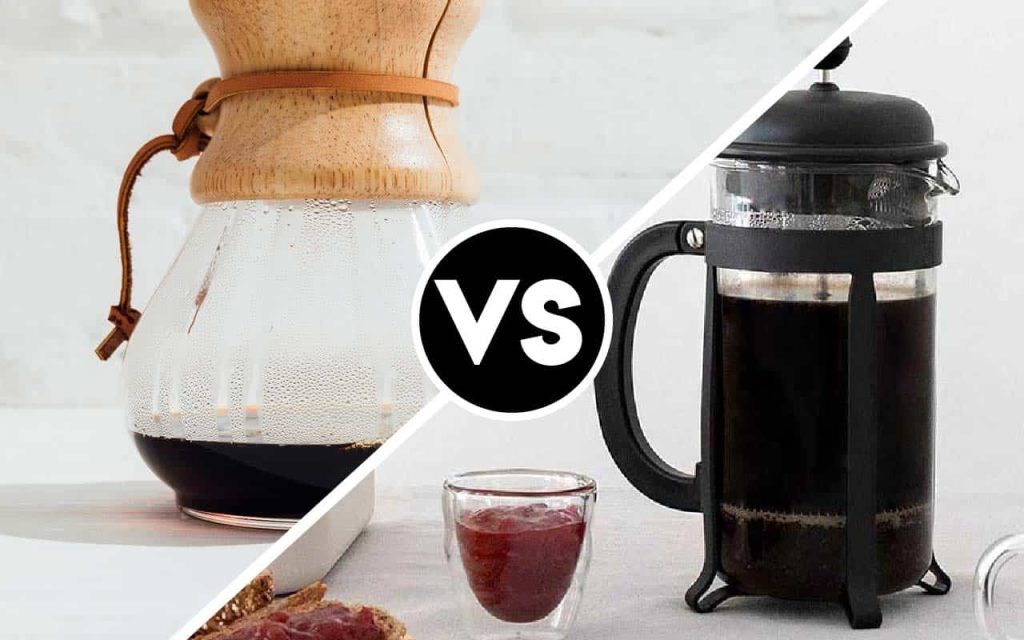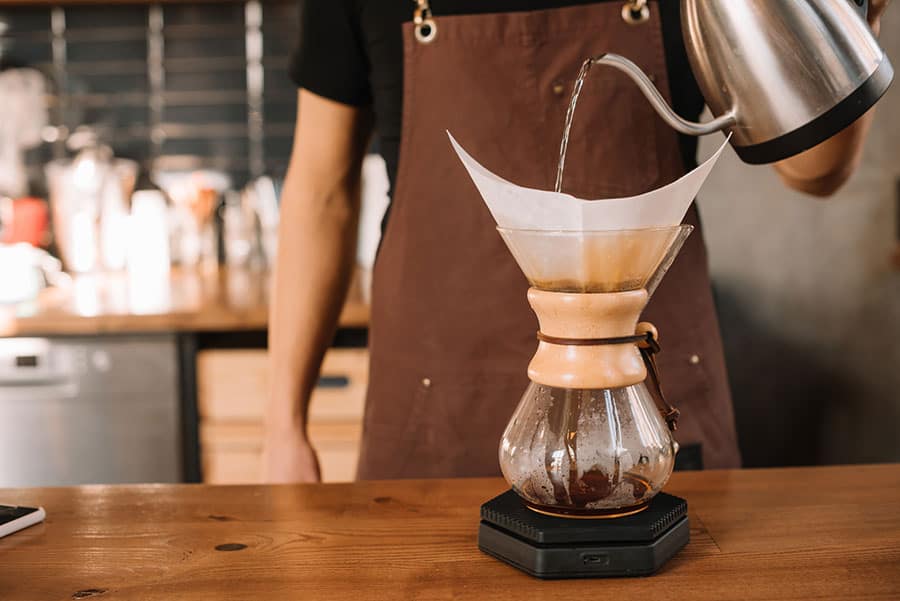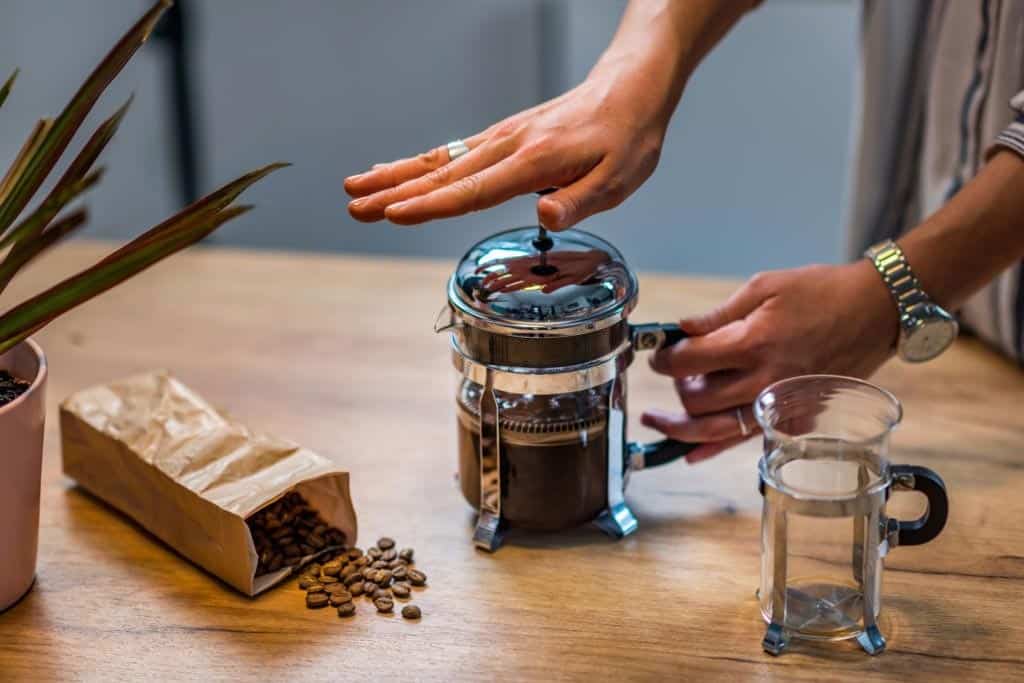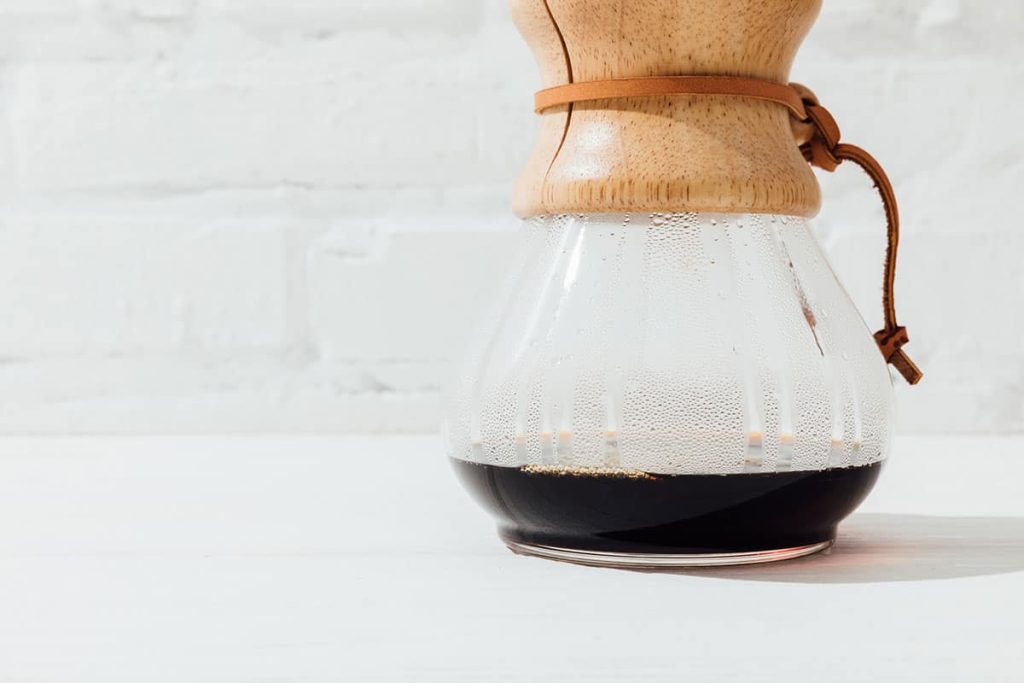Chemex vs French Press: Which One Should You Get?

In today’s article, I will tell you everything you need to know about Chemex vs French press. These two coffee makers have been used for years and will continue to be used because they are convenient, affordable, and they allow you to be involved in the brewing process.
If you have never tried out either of these coffee makers, you are in for a real treat. You will be amazed by how simple the entire brewing process is and how quickly it all happens. It takes only a few minutes of your time to brew an enjoyable cup of coffee that will help you get through the day.
I know that a lot of people like to use a regular coffee maker that brews the coffee without them having to be included in the process. That is great, but if you want to be more involved in the brewing process, I urge you to try using either the Chemex or the French press. You can figure out which one is more suitable for you if you stay with me through this guide!
Main Differences Between Chemex vs French Press
The main differences between Chemex vs French Press are:
- The Chemex has to be used with a coffee filter, whereas the French press can be used without a filter.
- The Chemex brews coffee through drip filtration, whereas the French press brews coffee through full immersion.
- The Chemex brews less acidic and less oily coffee, whereas the French press brews stronger and more acidic coffee.
Even though I start by talking about the differences between the Chemex and the French press, these two coffee makers are also very similar in certain ways. These are two great coffee makers that you need to have in your house, especially if you like to mix things up with your coffee every once in a while.
Once you try the coffee makers out, you can decide which one you want to use on a more regular basis. They are both great, but it ultimately comes down to your preferences – you have to decide which one you enjoy using and which brews better coffee according to your taste. To make that decision, you need to learn more about these coffee makers, so let’s get right into the details!
Chemex vs French Press: Overview
If you are someone who drinks coffee every day or even several times per day, chances are that you already know about Chemex or the French press. As mentioned before, they have a long tradition when it comes to coffee brewing.
However, you might not know exactly which parts these coffee makers are made from. I would like to tell you some general information about the Chemex and French press, and what better way to start than with the constituent parts and what purpose they serve!
The Chemex
I will start with the simpler coffee maker of the two – the Chemex.
The Chemex consists of a glass flask that is usually shaped like an hourglass. It has a wide body but a more narrow neck where you need to place a filter. The filter is the most important part of the Chemex – it is where the coffee is made. Depending on the type of filter you use, the taste of your coffee can be dramatically different.
The last part of the Chemex is the wooden collar which usually has a tie wrapped over it. This part serves as a safe space for your hand so that you do not burn your hand when you brew the coffee in the flask using hot water. Usually, the collar is made from maple or beech – this can be different depending on the manufacturer of the Chemex.
French Press
Now that you know all about the parts of the Chemex, I will move right to the French press.
The most important part of the French press is the plunger. You cannot make any coffee using the press if you do not have a plunger. The plunger serves to separate the coffee grounds from the actual coffee.
You put the plunger into the carafe which is a glass container. It usually has a metal frame with a handle attached to it. On top of it, you have a secure lid that allows you to close the container.
Some of the more expensive French presses can come with an additional filter, spiral plate, and cross plate. Even though it is nice to have all these parts, they are not that important for the actual brewing, so you do not have to worry at all if your French press comes without any of them.
Features Comparison
Knowing the constituent parts of these two coffee makers is not enough – you also need to know about their features to be able to easily determine which one is better for you. So next up, I will talk about the features of the Chemex and French press to help you understand the differences and similarities between them better. Let’s get right into it!
Coffee Grind
If you are trying either of these coffee makers out for the first time, I recommend that you give all types of coffee beans a try before you decide which one you like best for that type of coffee maker. You should always trust your taste buds to tell you which type of beans you should use.
Whatever coffee beans you decide to make your coffee with, the most important thing you need to do to bring out the best brew out of them is to have the right grind. For the Chemex, I recommend medium roasted beans with a medium-coarse ground. For a French press, you should go with medium or dark roasted coffee beans, coarsely ground.
Whatever you do, never go with fine ground beans when you are using either the Chemex or the French press. With these two coffee makers, fine grounds can easily get into the actual coffee and ruin your experience. You can try out different roasts and origins, but I urge you to stick with the medium-coarse to coarse grounds at all times.
Brewing Method

The Chemex and the French press have quite different brewing methods – the former is based on drip filtration, while the latter is based on full immersion. Let’s talk about these methods in more detail.
When it comes to drip filtration, what you need is a filter that will separate the coffee beans from the actual coffee. You place the beans in the filter and pour hot water over them. From the other side of the filter, the coffee will start to drip into the flask – hence the name drip filtration.
On the other hand, you have full immersion which is a method that requires a longer interaction between the coffee beans and the water. In the carafe, you add the grounds and pour water over them. After letting the two intertwine for a while, you use the plunger to remove the grounds from the coffee.

Even though both brewing methods are quite easy, the immersion one can be a bit trickier because of the plunger. If you do not press the plunger carefully, grounds can easily escape it and get into your coffee. This is less likely to happen with the Chemex, especially if you are using a high-quality filter.
Brewing Time
The brewing time of these two coffee makers is quite similar. Both can make a good cup of coffee within minutes – it usually takes anywhere from a couple of minutes to ten minutes tops for the coffee to be ready for drinking.
Brewing Control
In terms of control over the brew, both the Chemex and the French press allow you to have full control. You can determine the amount of coffee grounds and water that you want to use, as well as the brewing time. You can also choose the temperature of the water that you use, but remember – too hot water can damage your coffee maker, so be mindful of the temperature at all times!
Coffee Flavor
Another big difference between the Chemex and the French press is in the taste of the coffee. This is something you have to know – which coffee maker you get will depend mainly on the type of coffee it can prepare. So let’s see what type of coffee you should expect to get from these two.

I mentioned that the Chemex has to be used with a filter. Most Chemex filters are great at removing the oils and the acids from the coffee grounds, so the cup of coffee you get will have a rich and clean taste without much acidity.
On the other hand, the French press is used without a paper filter as it comes with a mesh filter in its plunger. This allows some of the oils and acids to make their way to the coffee. Your coffee will have a rich, full taste, but could also be a bit acidic.
If you are someone who has a sensitive stomach, French press coffee might not be the best for you. Acidic coffees can upset the stomach, so you should stick to Chemex coffee or try out other types of coffee makers.
Cleaning and Maintenance
In terms of cleaning, both are quite easy to clean and maintain. The cleaning of a Chemex can be slightly more challenging because the flask tends to be quite narrow at the neck, so you might not be able to get through that part with just about any tool. You will need to purchase a special tool to clean it.
However, it is very easy to throw out the coffee grounds – they stay in the filter, so you only need to take out the filter and throw the grounds from it. Depending on the type of filter you are using, you can either throw it away or clean it if it is reusable.
On the other hand, French presses are quite easy to take apart and clean. You can scrub all the parts using a regular sponge and cleaning solution. The grounds are easy to remove – you can choose to throw them out or use them as fertilizer.
Versatility
The Chemex is not a very versatile coffee maker. You can use it to make coffee and that is about it. However, I cannot say the same for the French Press. This press is very versatile and it can be used in several different ways.
You can use the French press to make tea, hot brew, cold brew, and double brew coffee. So if you are looking for a more versatile 2-in-1 coffee maker and tea maker, the French press should be a better choice for you.
Price
Finally, another factor you need to keep in mind is the price of the coffee maker. There is not a big difference between the Chemex and the French press when it comes to price – there are so many devices to choose from and their prices range from $10 to over $100.
I would recommend that you visit a specialty store and get yourself something of good quality. That way, you will have a reliable and durable coffee maker that you can use every day!
French Press vs Chemex: Winner
After reading all this information on Chemex and French press coffee makers, I hope that you have a clearer idea about which one you should get. I cannot say which one is the winner – you have to decide that depending on your preferences and needs.
Remember all of the features that I mentioned above when you go out to buy one of these coffee makers. I hope that the guide will help you make a better, more educated decision. In the comments, let me know what you decide and what the crucial piece of information was that helped you make your final decision!
Owen is a writer and editor at Caffe Streets who considers himself a coffee fanatic. He spends his time researching and testing different coffee beans and brewing methods and sharing what he learns with others.







